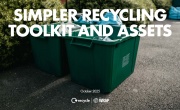Eunomia reinforces residual waste overcapacity prediction
Eunomia Research & Consulting has reinforced its analysis that the UK will reach overcapacity in its residual waste infrastructure by 2020/21, as presented in its twelfth issue of its Residual Waste Infrastructure Review (RWIR), limiting the amount of waste going for recycling.

The environmental consultancy released its latest RWIR last week and predicted that if there is a continuation of current trends, the treatment capacity would outstrip the available residual waste and set a ceiling of 63 per cent on the UK’s recycling rate.
That announcement was met with scepticism from the ESA, however, with Executive Director Jacob Hayler warning of a shortfall of treatment capacity by 2030, saying: "Eunomia’s findings are flawed and have been contradicted by report after report from everyone else who’s looked at our residual waste treatment needs.
“It is galling that they continue to repeat the message when we are crying out for more investment in our industry…. The consensus position on waste treatment is that we will end up over five million tonnes short of energy from waste capacity by 2030. This is what the government needs to understand if it is not to sleepwalk into a capacity crisis.”
New figures
In seeking to back up its predictions made in its RWIR last week and refute claims that there will actually be a capacity shortfall by 2030, Eunomia provided the following statistics:
- The UK landfilled around 11 million tonnes of waste at the standard rate of landfill tax last year but probably no more than nine million tonnes would be suitable or available for treatment by incineration.
- There are 4.8 million tonnes per annum (tpa) of residual waste treatment facilities under construction or in the project pipeline.
- To move from the current 44.3 per cent recycling rate to the 50 per cent municipal waste recycling target, to which the UK is already committed, means reducing residual waste by around 1.5 million tpa.
Eunomia states that, according to these figures, by 2020 the capacity gap will close to 2.7 million tonnes.
Responding to Hayler, Eunomia maintains that the position in 2030 is likely to be influenced by many variables and a capacity gap could be created if waste generation increases, recycling rates do not increase, the residual waste export market is significantly diminished, and very little of the currently committed capacity is constructed.
However, Eunomia points out that if waste does not start to grow and if recycling rates increase to 70 per cent, then residual waste arising will fall by seven million tpa meaning, even with no new facilities built other than those already under construction, that the UK would have around 2.8 million tpa more treatment capacity than residual waste for treatment.
Commenting on the debate, Eunomia Chairman Dr Dominic Hogg said: “The exact date when UK treatment capacity will exceed the available waste is debatable, as it depends on the rate at which facilities are built and progress on recycling; but in the context of 25-year investments, it is not the relevant issue. The ultimate destination is clear, whether the UK gets there in 2020, as the latest RWIR projection suggests, or a couple of years either side.
“The sensible response is to indicate the long-term trajectory for UK waste and resources policy by setting ambitious targets, or implementing policies, which clearly indicate – before significant additional incineration capacity is built – the intention to reduce substantially the amount of residual waste generated in future.”
Eunomia’s latest Residual Waste Infrastructure Review can be read on the company’s website.









